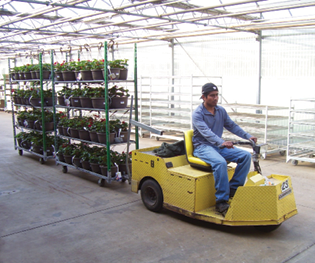
If you spend more than two hours a day walking to supervise personnel or check on plant growth, the cost of an electric cart can be recovered in about one year. Small, single-seat vehicles are available for this purpose. Some are available with a platform to carry a few plants or other material.
Electric-powered vehicles are also available for materials handling. These are capable of carrying several thousand pounds of growing mix or containers or used to pull several tracking plant carts at a time.
How do these work?
Electric vehicles use four or six industrial batteries to supply power to a heavy duty direct-current motor. Most carts used in greenhouse operations have four to 10 horsepower motors. Speed control and forward/reverse switches make operation simple.
After an overnight charging, a vehicle will operate all day long under normal use. Recharging costs less than $1 per day or about half the cost of operating a gas-powered vehicle.
Selecting a vehicle
The first step is to decide on the primary use. Personnel carriers are characterized by a driver compartment and additional seating for employees. Cargo carriers have a driver compartment and bed area for the load. Tow tractors can have either a stand-up or seat compartment and usually a very small cargo area.
Size and capacity are important. For use as a special order chaser or maintenance vehicle, a bed size up to 3-by-5-feet is adequate. In small operations where distance is short and space limited, a smaller vehicle may be desirable. In larger operations, and those where plants are grown outdoors, a larger vehicle can be used to advantage.
Motor horsepower rating will depend on the load to be carried or pulled, the grade to be climbed, if any, and the speed of movement. Most manufacturers have options to fit your needs.
Tire size affects the smoothness of operation and amount of flotation. Larger diameter wheels, 16 or 18 inches should be selected for outdoor operation. Pneumatic tires are standard on most vehicles.
Reviewing the options
Several battery options are available. They are rated on amp-hours of capacity. For intermittent duty or light handling, standard industrial batteries work well. Continuous use or operation near rated capacity requires heavy duty batteries. A new lithium-ion battery (valence.com) can provide twice the available energy. Batteries generally have a two-year useful life.
Chargers are available in two versions: portable or built in. Portable chargers can be bench or rack mounted. Built-in chargers are located under the vehicles deck or seat. Because they can be plugged into any 120-volt electric outlet, the vehicle does not have to be returned to a central area.
On older style vehicles, speed control is by a rheostat. Voltage at the motor is controlled by directing the flow of electricity through different amounts of resistance. Three to five speeds are commonly available. The more efficient solid-state controls are common today and provide protection against overloading and just about eliminate control maintenance.

Most manufacturers offer a wide variety of options. Mechanical brakes work well on vehicles up to 1-ton capacity. Where heavier loads are carried or the vehicle operates at higher speed, hydraulic brakes are preferred.
Cab and cargo body closures should be considered if the vehicle will be operated outdoors during inclement weather. Both molded fiberglass and steel are used. Cabs should have removable doors for cooler summer operation. For towing carts, a quick attach hitch should be added.
Electric vehicles require minimum maintenance. Periodic lubrication of movable parts is about all that is needed. Expendable parts that may need replacement occasionally are the forward/reverse switch, rheostat speed control, brakes and motor brushes.
Battery-powered carts are available used for $800 to $5,000 and new for $4,000 to $15,000.

Explore the June 2016 Issue
Check out more from this issue and find your next story to read.
Latest from Greenhouse Management
- Anthura acquires Bromelia assets from Corn. Bak in Netherlands
- Top 10 stories for National Poinsettia Day
- Langendoen Mechanical hosts open house to showcase new greenhouse build
- Conor Foy joins EHR's national sales team
- Pantone announces its 2026 Color of the Year
- Syngenta granted federal registration for Trefinti nematicide/fungicide in ornamental market
- A legacy of influence
- HILA 2025 video highlights: John Gaydos of Proven Winners





